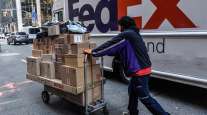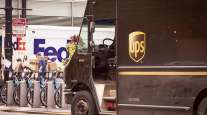Bloomberg News
UPS, FedEx Face Stress Test From Amazon’s ‘Christmas Creep’

[Ensure you have all the info you need in these unprecedented times. Subscribe now.]
FedEx Corp. and UPS Inc. are girding for their biggest test yet in the e-commerce era, with “Christmas Creep” pushing the holiday shopping season ever earlier and stretching the limits of shipping networks already strained by the COVID-19 pandemic.
Promotions by Amazon.com Inc. and rivals that began Oct. 13 are forecast to spur $10 billion in sales, accelerating holiday purchases and outstripping last year’s post-Thanksgiving Cyber Monday spree. With legions of consumers staying away from stores this year, the parcel carriers are already handling record deliveries and bumping against capacity constraints.
“Prime Day will be a very good test,” said John Haber, founder of logistics consulting firm Spend Management Experts. “If they can handle all the packages coming out of the gate here and do that smoothly, that’s a good sign of things to come. If they have problems, those problems probably won’t go away.”
FedEx and UPS perform a peak-season balancing act every year that involves computer models and customer discussions. Adding too few resources can create havoc for retailers and customers, while beefing up payroll and capacity too much can dent couriers’ profits. New consumption patterns this year fueled by the pandemic, plus signs that consumers plan to shop earlier than usual, have introduced a measure of guesswork into the planning.
The big couriers have already been hiring seasonal workers to handle higher-than-usual volume, ramping up earlier than they typically do. FedEx increased capacity by rolling out seven-day service to 95% of the U.S. population and introduced new routing software that lets it handle unusually large residential packages.
“Because we’ve had the resources on already and, over the top of that, we’re now adding on peak resources, I think we’re well positioned to handle the volume,” said Henry Maier, chief of FedEx’s Ground unit. “We’d move aggressively to accommodate anybody who thinks they’re going to be shipping significantly higher than normal.”
Large retailers — which typically get volume discounts — must be more flexible on schedules. FedEx and UPS, for example, have increased weekend capacity for pickups and delivery. Shippers will also be pressed to prepare trailer loads of packages for delivery.
“It’s mostly large customers that will make those changes,” Maier said. “We’re making sure they understand where capacity is available in the network and on what days and what times, so we can do our best to fill their expectations at peak.”
Small retailers, which don’t get the big discounts like large shippers, won’t be as affected by the tight capacity, he said.
UPS’s network is ready for the volume generated by Prime Day and promotions by other retailers during peak season, said spokesman Glenn Zaccara.
“We are working closely with our large and medium customers to steer volume to capacity and ensure the UPS network is reliable for all customers,” he said by email.

A FedEx worker unloads a truck in downtown Dallas, Texas. (Cooper Nell/Bloomberg News)
Maxing Out
Preparations by FedEx and UPS notwithstanding, the shipping industry as a whole is nearly maxing out.
“Everybody — regionals and nationals alike — are at capacity and then some,” said Dick Metzler, CEO of Lone Star Overnight.
The Austin, Texas-based courier, which serves nine states, stopped taking big new e-commerce shippers about a month ago. Lone Star plans to hire individuals using their own cars to deliver packages if the company’s trucks are overwhelmed — a technique that Amazon and UPS also use.
“My sense is there’s going to be a shortage of capacity, just based on the number of people that we couldn’t add,” Metzler said.
RELATED: Trucking Industry Economy Outpaces US Economy as Capacity Tightens
Higher volume and increased prices during the pandemic have helped FedEx and UPS weather increased expenses and the decrease in commercial business during early lockdowns. Sales at FedEx’s ground unit jumped 36% in the company’s latest quarter, pushing profit well above analysts’ estimates. UPS is set to report earnings Oct. 28.
Investors have been enthusiastic, sending FedEx jumping 80% this year through Oct. 13 and pushing UPS up 50%. The S&P 500 Index rose 8.7% during the same period.
The couriers, as well as the U.S. Postal Service, have added additional surcharges for the peak season to cover added expenses for surging volume. Smoothing out volume will be important and if forecasts about purchases creeping earlier in the season are correct, courier profits could be strong.
“The message we’ve given everybody in this is that you need to ship early,” said Maier, of FedEx. “The thing that is different this year is the extent to which you can pull that volume forward out of the first week of December.”
UPS ranks No. 1 on the Transport Topics Top 100 list of the largest for-hire carriers in North America and No. 2 on the Top 50 list of the largest logistics companies.
FedEx ranks No. 2 on the for-hire TT100 and No. 15 for logistics.
Want more news? Listen to today's daily briefing:
Subscribe: Apple Podcasts | Spotify | Amazon Alexa | Google Assistant | More




